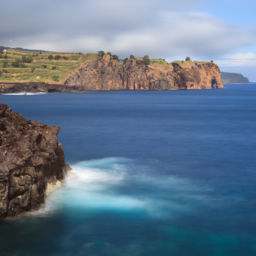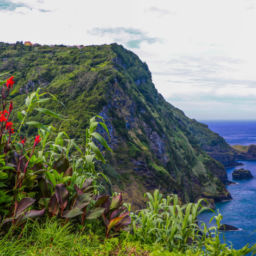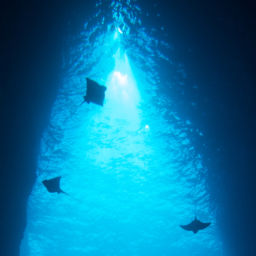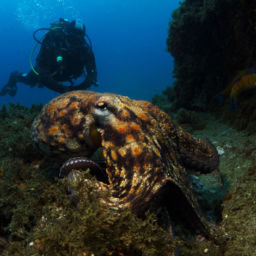When the light begins to fade in the vast Atlantic, a multitude of critters and creatures begin to appear in your torchlight. Some are minuscule; others vast, but the bounty of life here is limitless. You never know what you may encounter next when night diving in the Azores.
Night diving in the Azores
Throughout the Azorean archipelago, deep ridges and sudden drop-offs create a plethora of life close to shore. Plankton and microorganisms also rise from the depths in the night, searching for food. Jumping from the São Caetano harbor, the moon illuminates the giant volcano of Pico Island behind us. The water below is filled with small baitfish and sleeping parrotfish, whose rainbow colors never cease to amaze. Octopus await in their hideouts, eager to pounce on unsuspecting prey. Meanwhile, morays spring from their holes if prey strays too close to their razor-sharp teeth. We descend past the rocky outcrops and deeper toward a sand patch.
The water is even darker here; the glow from the moon almost gone. The sand is home to many species. None is more beautiful that the thornback ray, whose leopard pattern appears out of the gloom. Larger predators lurk here, like the giant red scorpionfish and the monkfish with its searching antenna, forever looking for an opportunity to strike. Small patches of lava ridges reveal anemones, which by day are almost unnoticeable. In contrast by night, they rise and stream in the current like long hair in the wind.
Small fish dart in the torchlight, oblivious to the pelagic predators behind them. In a flash a barracuda has hit, cutting a fish in half right in front of our beams. It’s a vicious world in the night. At the deepest point of the dive a wall descends from 50 feet (15 m) into oblivion. We peer over the edge and a river of red flows over the precipice — shrimp in the thousands stream toward the shallows in search of food on the sand.
We ascend back toward the rocks and our torchlight dims in a cloud of red — krill swarms through the water, attracted by the light. In unison the divers turn off their lights and the darkness is illuminated by bioluminescence from the minuscule creatures. Blues and greens shine in the ocean like a billion stars. We return to the harbor where we began the dive where one more surprise awaits. A group of squid, about a foot long each (.4 m), shine with transparent skin as they pump through the water before disappearing into the darkness.
Average depth: 50 feet (15 m)
When to go: May through September
Average water temperature: 59 to 73 F (15 to 23 C)





